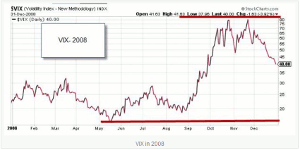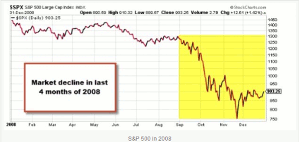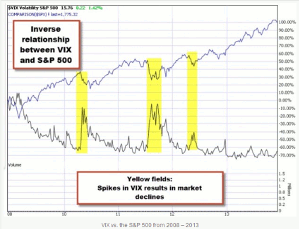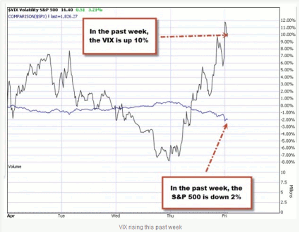Option expert Alan Ellman of TheBlueCollarInvestor.com explores whether a higher VIX level is a positive or negative for covered call writers.
Options trading basics teaches us that the VIX or CBOE Volatility Index demonstrates the market’s expectation of 30-day volatility. It measures market risk and is also known as the investor fear gauge. With this in mind, covered call writers are faced with a dilemma. Increased market volatility will translate into higher option premiums because the time value component of the premium is directly related to volatility. On the other hand, high overall market volatility increases our risk as share value can plummet and erase our initial gains. So is a higher VIX a positive or a negative?
One question that is frequently posed to me is that if the VIX is low do we stop selling calls because of lower premiums? This implies that a high VIX is a positive for covered call writers. Let’s take a look at an extreme example in 2008 when the VIX went from the 20-30 level to the 70-80 level in the last four months of the year:
As a general rule, the VIX and the performance of the overall market (S&P 500) are inversely related as demonstrated in the chart below where the market takes a dive in the last four months of the year:
To confirm this relationship, let’s look at a comparison chart of the VIX and the S&P 500 since the decline in 2008. In the chart below, note how the VIX has been declining while the overall market has been accelerating. Whenever there was a short-term spike up in the VIX, there was a corresponding decline in the market performance:
This Past Week
With the markets reflecting huge price swings this past week, we would expect a rise in the VIX and an inverse movement of the S&P 500. Here is the comparison chart as of 10:00 am ET on April 11, 2014:
VIX and Covered Call Writing
Covered call writing is a conservative strategy and those who use it are generally conservative investors looking to generate cash flow with capital preservation in mind. As such, a high VIX is no friend of covered call writers although we can use our common sense principles to manage those scenarios. A low VIX (under 20) is usually a positive for us because it means a more stable market and oftentimes a rising market as we have experienced since early 2009.
How to Manage a High VIX
We can “stay in the game” by selling in-the-money strikes, using options with lower implied volatility (set goals at 1-3% instead of 2-4%) and use low-beta stocks.
How to Manage a Low VIX
This is one of the factors that will give us the confidence to take a more bullish stance and sell at-the-money and out-of-the-money strikes with higher-beta stocks and higher implied volatility options.
Conclusion
The VIX is a factor that should be considered in our covered call writing decisions. It should neither be feared nor embraced but rather managed using the fundamental, technical, and common sense principles of the BCI methodology.
By Alan Ellman of TheBlueCollarInvestor.com

























